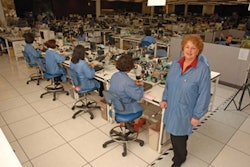By John LaPorta
In the IBM Chief Procurement Officer (CPO) Study, which gathered perspectives from over 300 chief procurement officers (CPOs) and other C-level executives on their current procurement performance and future expectations, three key messages resonated:
- Procurement has become a key competitive weapon – procurement performance has a broad and direct impact on corporate performance.
- The role of procurement is changing fundamentally – procurement professionals need to become business partners, not just buyers, and the CPO needs to transition to the role of "chief performance officer."
- The demands on procurement are forcing an ongoing battle for talent – procurement skills shortages will be the single biggest obstacle to success.
These three messages exemplify the need to focus on having individuals with the right skills available in a timely manner. With the proper talent in place, procurement is in a position to create long-term value for the organization.
To address this need for procurement talent in this day of outsourcing, out-tasking and offshoring, "in-house growing" is a concept that is worth considering. Recent industry and media articles have well documented the U.S.' upcoming labor shortage, resulting from the Baby Boomers entering retirement. One in four of the working population will reach retirement age by 2010 which translates to a potential shortage of nearly 10 million workers. This exodus of talent, coupled with the ongoing globalization of supply chains, is forcing organizations to rediscover the merits of developing their most important asset – their people.
Progressive organizations have been working very diligently to develop their procurement staff to meet the current and future needs of their companies. These companies are looking to accelerate a set of predetermined skills that are crucial for their procurement department. Where normal training and classroom work could take up to two years, these companies need to accelerate their skills development within a four- to six-month window. To address this requirement, organizations should consider implementing a procurement capability accelerator program. There are three main steps in this type of innovative program: 1) Close the gaps in skill sets needed to be a best-in-class organization; 2) take current highly skilled personnel and reposition them within the procurement organization with the correct knowledge and tools; and 3) fill the pipeline in the organization with individuals with the correct skills to plug the vacuum created by retiring staff and talent shortages.
Identify the Expected Outcome
First and foremost, a company needs to view its procurement organization as a tool for achieving competitive advantage and shareholder value. Without this type of top-down view and total management commitment, a procurement capability accelerator program will fail. Also, for a company to proceed with the program, there needs to be a linkage between the dollars invested in its people and a return on investment (ROI). Once there is agreement from management that this is the proper course, you will need to show how this investment correlates into value. We will expand on this further, later in the discussion on how to approach the measurement of this program.
Establish the Skills Baseline
The next critical task after management commitment is to establish the baseline. If the starting point is not understood, how can a destination be determined? Knowing where skill gaps exist is necessary if improvements are to be realized. Once a group of individuals has been identified to participate in the program, a skills assessment should be required of each individual. This assessment will vary depending on how the program is structured (some customization will be required based on the industry and the strength of the procurement department) and which capabilities need to be accelerated. A skills assessment should be conducted by an objective third-party in order to protect the confidentiality of the findings. Examples of skill areas are:
- Developing and executing a strategy
- Program and/or portfolio management
- Leadership enrollment
- Strategic communications
- Strategic sourcing and procurement tools
- Financial decision making, total cost of ownership and cost modeling
- Supplier relationship management.
Once the assessments are complete and mapped to the skill areas by individual, a determination should be done on the gap in skills by area and an appropriate development plan should be outlined to close these gaps. Below is a sample assessment tool chart that can be used to map current skill to preferred skill level and show how much of a gap exists. In this example, the assessor used a predetermined survey with question sheets that were given to the participants.
Figure 1: Agreed Score vs. Generic Norm for Role
Communicate the Program Benefits
A well-structured communication strategy is paramount to any successful procurement capability accelerator program. The organization needs to ensure that the constituents understand the difference between this program and traditional training programs. Four key items need to be emphasized when conveying the message to the individuals who will be participating:
- Accelerated learning techniques;
- Work-based learning, i.e., "action learning";
- A tailored structured learning framework delivered through a compressed timetable;
- Knowledge management through networking and effective repositories.
One approach is to have the CEO or senior executive send out the initial communication letter to the individuals tagged to participate in the program. This type of communication ensures that the company's commitment to the program will go unchallenged. The next step would be to have a kickoff meeting with the participants to lay out the program, communicate the program details and take the participants through the step-by-step sequence of what they will be doing over the coming months.
Select the Right Participants
The program should be structured so that it compresses two years of personal development into an intensive six-month period using expert, on-the-job coaching. The participants should be selected according to their role, interest level and potential ability to develop further expertise within the procurement discipline. Each participant should be independently assessed against "role model" job profiles, covering a comprehensive skill set (i.e., not just technical). Following this assessment, a tailored "learning" plan should be developed for each individual, informed by the identified skills gaps, the relative importance of each skills area, and the individual's ability to apply the learnings. The program can be managed internally or externally, supported by expert coaches from both internal and external sources. The fundamental design of the program should align the timing of the coaching interventions to business challenges facing the participant, unlike conventional training, which is generically delivered and used on an "opportunistic" basis. In this sense, the program applies skills development to delivery of business results in "real time."
The program should commence with an initial orientation event. Following the individual skills assessments, an induction event is held at which participants receive a tailored personal learning plan that lists the modules deemed appropriate and relevant for them, addressing the skill gaps identified during their assessment, and that includes the coaching hours related to each module. Depending on the company, you may have all participants complete prerequisite foundation learnings. These prerequisites could include management accounting, economic evaluation and stakeholder management. Once these learnings are completed, the program will commence. As stated, the goal is to complete all teachings, coaching and classes within a six-month timeframe. Individuals only complete the modules necessary to fill their unique skills gaps and to achieve the desired competencies for their role.
Measure Success
To ensure the ongoing viability of the program, it is critical to measure its success. One example of an organization that recognized the need to accelerate their procurement capabilities and quantify any benefits realized is BP p.l.c (BP). BP made a conscious decision from the top down to develop, enhance and drive long-term value through enhancement of its procurement organization. At the onset, BP established a baseline of its current procurement capabilities. They understood and bridged to each individual's performance expectations and their commitments for the year. With this approach, when the outcomes were reviewed in eight to 12 months, they could determine if the program enhanced performance as compared to results from previous years.
The areas BP measured were:
- Program effectiveness through communication programs with key stakeholders;
- Timing of the program execution by examining rollout plans;
- Additional savings derived from total cost of ownership (TCO);
- Comparison of savings achieved before and after the program rollout.
Due to their initial success, BP is maintaining this program and has made it sustainable through hard work and strong leadership. In recognition of these efforts, BP received the 2006 Institute for Supply Management's (ISM) R. Gene Richter award for leadership and innovation in supply management in the "People" category.
Create a Sustainable Learning Environment
Ideally, a program to accelerate procurement capabilities should be viewed as an intervention to provide a swift step improvement in skill sets in support of delivering savings and long-term business value. However, many of the features of this program should be developed into a sustainable learning framework for procurement professionals throughout your organization, such as:
- Creation of a "pull" for learning;
- Inclusion of expert coaching in order to take the application of skills to the next level;
- Assessment of skills gaps being consistently calibrated;
- Personal learning plans being informed by skills gaps, relative importance of skills and ability to apply learnings;
- Proactive management of selection into each learning module;
- Program management in creation and delivery of learning plans;
- Learning modules covering total skill sets required, not just technical procurement areas;
- Measurement of learning impact on stakeholders.
The sustainable learning framework will reach the whole procurement community and should also include mentoring and knowledge management.
This program is not for everyone as it is dependent on an organization's philosophy and its strategic view of procurement. If your organization would benefit from assessing and growing procurement talent through these three steps, then this type of program would fit into your organization and help to:
- Satisfy voids in skill sets needed to be a best in class organization;
- Take current high skill personnel and reposition them within the procurement organization with the correct knowledge and tools;
- Fill the pipeline in their organizations with individuals with the correct skills to plug the void created by retiring staff and talent shortages.
If these are reflective of your organization, then the concept of "in-house growing" may be the right approach to enhancing your procurement capabilities.



















